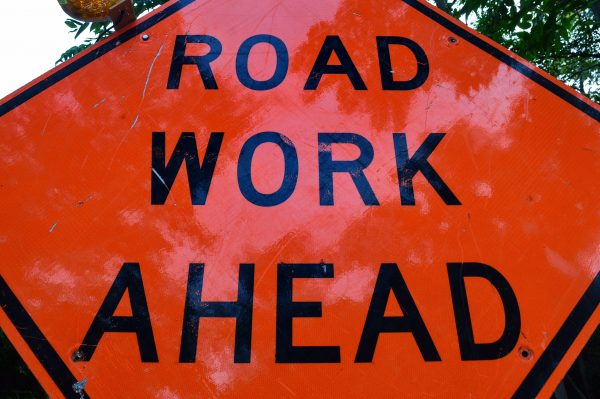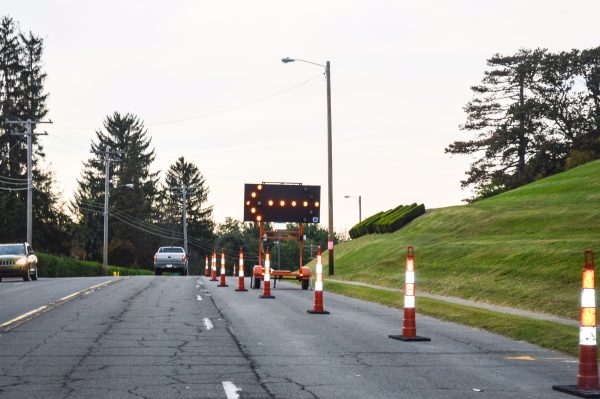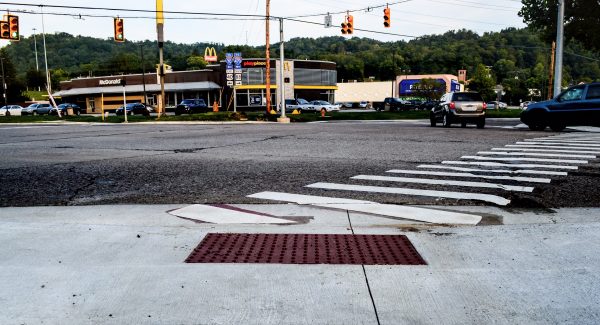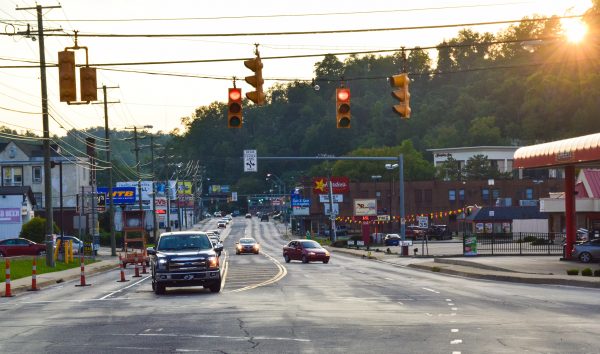He was being honest when he said it.
“This job sometimes keeps me up at night,” admitted Gus Suwaid, the chief engineer of the Division of Highways District 6. “And I lose sleep because of all the issues we have, from Tyler County through Hancock County. But we have made progress.”
That includes the improvements being made now along National Road through the heart of the city of Wheeling, an extended project that has tested the patience of motorists for the past month. From the area where Perkins Restaurant rests all the way to the Elm Grove neighborhood, walkway access ramps have been constructed to meet updated standards mandated by the Americans with Disabilities Act of 1990.
“The way we’ve approached those projects can be summarized into three different reasons,” Suwaid explained. “There’s the protection of the work because fresh concrete has to be separated from live traffic. The drop-off from that concrete to the roadway is another reason why it’s happening the way it is, and that’s to secure public safety.
“The last reason is the most important reason, and that is if it was being performed in any other way, it would be very cost prohibitive,” he continued. “As far as taxpayer dollars are concerned, it wouldn’t make much sense to do it one project at a time. Plus, many of the cones used for lane closures are placed at the curbs and are not blocking the lanes from traffic. It’s true in some areas to protect the work, but it’s not true all along U.S. 40.”
In about two weeks, Suwaid reported, the final phase involving the walkways will be completed, and then paving will be performed along the historic stretch of U.S. Route 40.

“From Perkins to Bethany Pike, those walkways were completed as of this past week, and then the walkways on the east side of U.S. 40 in Wheeling have also been completed,” Suwaid reported. “There will be work on those walkways at the intersections in the middle area to bring them up to ADA compliance, and that will take two more weeks to complete.
“There are two separate contracts, and fortunately the same contractor was awarded both contracts and that’s because it all depends on the timing of when the funding is expected to be available to pay for those contracts,” he said. “The first section from Perkins to Bethany Pike was in dire need of a rehab project as was the area of U.S. 40 in the Elm Grove area. It’s taken a lot of hard work to make those projects happen, but they are.”
It is possible, the chief engineer explained, that there could a waiting period between the completion of the ADA work and the paving.
“The same contractor that is now performing the overlay paving along Interstate 70 from Exit 5 in Elm Grove to Dallas Pike will be the contractor for the paving of National Road, so there will be some crew movement from one contract to the other,” Suwaid said. “I am hopeful we can start the milling and paving on U.S. 40 earlier than planned, but I do know that it will completed by the end of October.

“And the U.S. 40 project is just one of many that have taken place so far in Ohio County, and we’re not done yet. But the end of 2016 there will have been more than $10 million spent on those projects in Ohio County alone, and I can’t recall when that many dollars have been used to improve the infrastructure in Ohio County,” the district engineer said. “In the end we will have improved National Road, Kruger Street, the concrete overlay at the I-470/I-70 split, the paving of I-470 and I-70, the lighting along our interstates in Ohio County, the paving from Elm Grove to Valley Grove, W.Va. Route 2 to Warwood, W.Va. Route 88 from Bethlehem to the Elm Terrace area, Peters Run Road, and G.C.&P. Road to Oglebay. And again, we’re not done yet.”
Suwaid reported that more than $10 million will have been expended in Ohio County alone by the state and federal governments by the time 2016 comes to a close, an amount unprecedented in the county during his 28 years with the state’s Division of Highways.
“We are not done yet with that $10 million because there’s still work to be completed,” he said. “We still have time left bfore the weather changes to get a lot of other projects completed. We’re also looking into the future as far as the needs that are present in Ohio County and throughout the District 6. It’s a fairly large district with a lot of improvements needed.
“Interstate 70 represents a lot of those needs in Ohio County, and since the concrete fell from one of the bridges in the Elm Grove area last weekend, more people now are aware that those bridges need attention,” he continued. “If you count the ramps as bridges, there are 15 of them that are in need of improvement.”

When those issues will be addressed is unknown right now, but Suwaid said it needs to be sooner than later in the Mountain State’s Northern Panhandle and throughout the country, and an example of that need surfaced one week ago along Interstate 70 in Elm Grove. Last Sunday afternoon concrete fell from the bridge that rests above U.S. Route 40 near Arby’s, closing the middle lane for several hours before crews fashioned the repair.
“This is an issue that all states are trying to manage right now, and it means we’re going to have to go through a cycle of rehab. At least that’s what I am trying to do here in this district,” Suwaid said. “We have a lot of infrastructure that has exceeded, or is about to exceed, design life, especially with the bridges we have in the district.
“I do see the 3-P delivery to be the most viable option right now,” he explained. “We’re looking at improvements that will cost between $120 million and $150 million and, the 3-P option is a public-private partnership concept because it would allow for a payment system between the state and the contractor that would spread out the payments more than if it was a common contract.”
In the end, however, it is the taxpayers footing the multi-million-dollar bill.
“The state and federal governments will still pay the contractor, of course, but the 3-P proposal would allow for those payments to continue even after that work is completed,” Suwaid explained. “Instead of coming up with that huge amount money all at once, government would be able to spread it out and make payments for a period of time during and after the improvements are made in installments. Ultimately, the contractor would also collect an amount in interest for agreeing to the program.

“The contractor would not absorb the risk by extending that payment horizon,” he said. “Ultimately, the public sector is still responsible, of course, but this option would allow the public sector to pay for the work at a more comfortable pace than what is possible right now.”
Will more chunks of concrete fall from one of many bridges initially constructed in the mid1960’s? Will tiles once again fall from the roof of Wheeling Tunnel? Will another Greyhound bus driver choose to cross the Wheeling Suspension Bridge?
All questions with unknown answers and that is what worries Suwaid the most.
“There is a lot of work to do next year, too, but it is all tentative because of how the funding works, and when you are dealing with contracts the size of what we’ll be dealing with, the public should expect a lot of planning to make sure the taxpayer dollars are being use as wisely as possible,” he said. “The plan, the way it stands right now, is to address these issues on Interstate 70 by the end of 2017 but, again, it’s all tentative, but I am encouraged because of the amount of work that is being performed this year.
“We do have a consultant on board right now to help with the planning of every project that needs completed in Ohio County and throughout District 6,” he added. “There is no fixed strategy as of yet because there are options there. Do we do these projects in a certain sequence? Do we do them all as one big contract? That’s all being worked on, but decisions will be made in the near future.”
(Photos by Steve Novotney)





